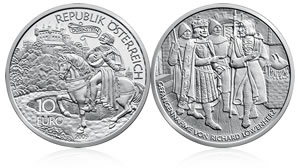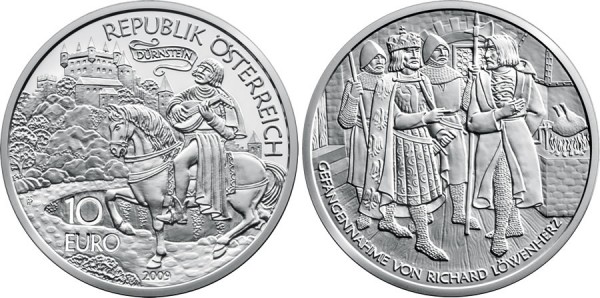Richard the Lionheart Silver Coins
October 20, 2009 by Darrin Lee Unser · Leave a Comment
 Available now from the Austrian Mint are 10 Euro Richard the Lionheart Silver coins, the second issue in the Tales and Legends in Austria series. Struck from sterling silver (.925 fine), each coin tells the story of royal proportions involving kings and dukes, queens and minstrels.
Available now from the Austrian Mint are 10 Euro Richard the Lionheart Silver coins, the second issue in the Tales and Legends in Austria series. Struck from sterling silver (.925 fine), each coin tells the story of royal proportions involving kings and dukes, queens and minstrels.
One would not normally think of Richard, King of England, to be part of a legend of Austria, but that is precisely the case. The tale starts out shortly before Christmas in the year 1192. Richard, known already as "Lionheart" for his great military leadership, was returning from the Crusades when he was shipwrecked. Forced to continue his journey home on foot, he and a couple of followers disguised themselves as pilgrims, not wanting to raise attention. This subterfuge was quite necessary as Richard had offended many nobles in Europe, notably the Austrian Duke Leopold who at one time served with Richard in the Crusades.
Several versions differ on the exact cause, but Richard’s disguise failed and he was arrested and imprisoned by Duke Leopold. The Duke was willing to release the captured King, but only if a hefty ransom was paid, 100,000 Cologne Marks of silver, or approximately 23 tons. As stated before, most of Europe had no love for the King, including his brother Prince John who planned to assume the thrown if Richard did not return. The King’s mother, however, Queen Eleanor of Aquitaine started the process of obtaining the funds.
An interesting side-story to this historical occurrence involves the King’s minstrel, Blondel. It is said that Blondel and King Richard composed songs together and were good friends. Upon hearing of the King’s capture, Blondel rode the countryside singing by every castle he came upon in search of Richard. Finally, in the castle of Duernstein, Richard heard the song and yelled out to Blondel, instructing him to seek help.
In the end, the ransom was paid and King Richard was set free. Of note, Duke Leopold created the Vienna Mint in 1194 (which is now the Austrian Mint that produces this coin) to strike coinage from the ransomed silver he received.
Richard the Lionheart Silver Coin Design and Specifications
The 10 Euro Richard the Lionheart Silver coin is available in proof, uncirculated and circulated versions. Each proof coin comes with a numbered certificate of authenticity and will be part of the maximum mintage of 40,000. Up to 30,000 of the uncirculated coins will be struck along with 130,000 of the circulated issues.
Thomas Pesendorfer designed the coin with Blondel the minstrel strumming his mandolin under the castle of Duernstein as he finds Richard. Also on the obverse of the coin are the inscriptions "Republik Osterreich," "Durnstein" and "10 Euro."
On the reverse side of the coin, an image of Richard the Lionheart is seen, covered in a cloak, but his royal garments still visible underneath. An elaborate signet ring is seen on his right hand. Duke Leapold I is shown in the process of arresting King Richard, with two armed guards behind them. "Gefangennahme von Richard Lowenherz" (Capture of Richard, Lionheart) is inscribed below the figures.
Richard the Lionheart follows the Basilisk of Vienna coin issued earlier this year as part of the Tales and Legends of Austria series. Early next year, the discovery of the iron rich area of "Eisenerz" in Styria will be featured on the third coin of the series.
Richard the Lionheart Silver Coin Image
For additional details, read the Austrian Mint press announcement about the coins.
About the Austrian Mint
The Austrian Mint is situated in the heart of Vienna and is the official minting authority for Austria with a 800 year history.
The Mint is the source for all Austrian Euro and Cent coins, whether they are intended for shopping, as an investment or for collection. Before the Euro, the Schilling and Groschen coins were minted, and before that – during the monarchy – Crowns, Guilders and Ducats were struck by the Austrian Mint.
The company is located close to the centre at the Vienna Stadtpark in a Biedermeier building erected under Emperor Ferdinand I. from 1835 to 1837. Today it accommodates one of the most modern mints in the world.
![[Most Recent Quotes from www.kitco.com]](http://www.kitconet.com/images/quotes_2a.gif)





